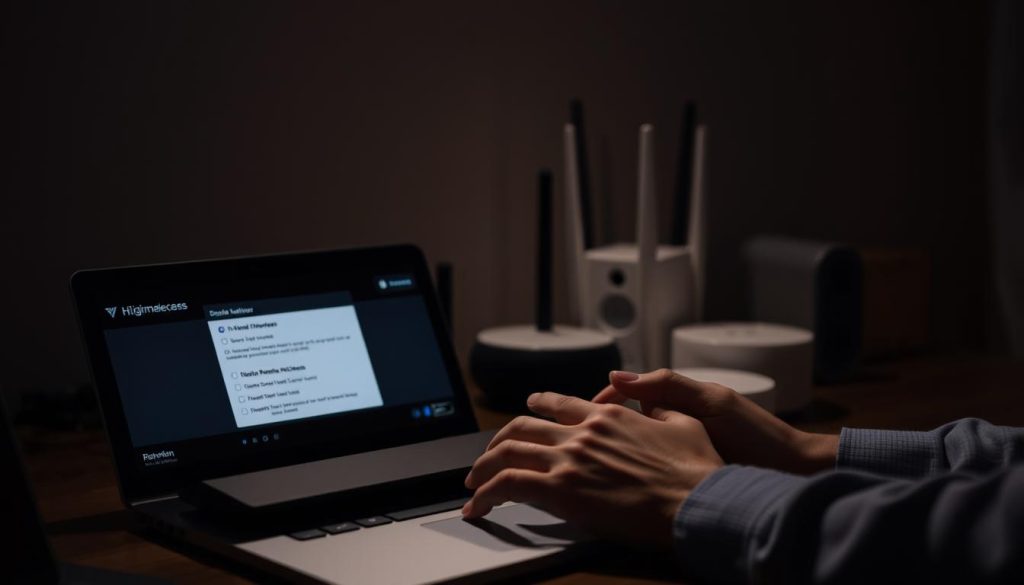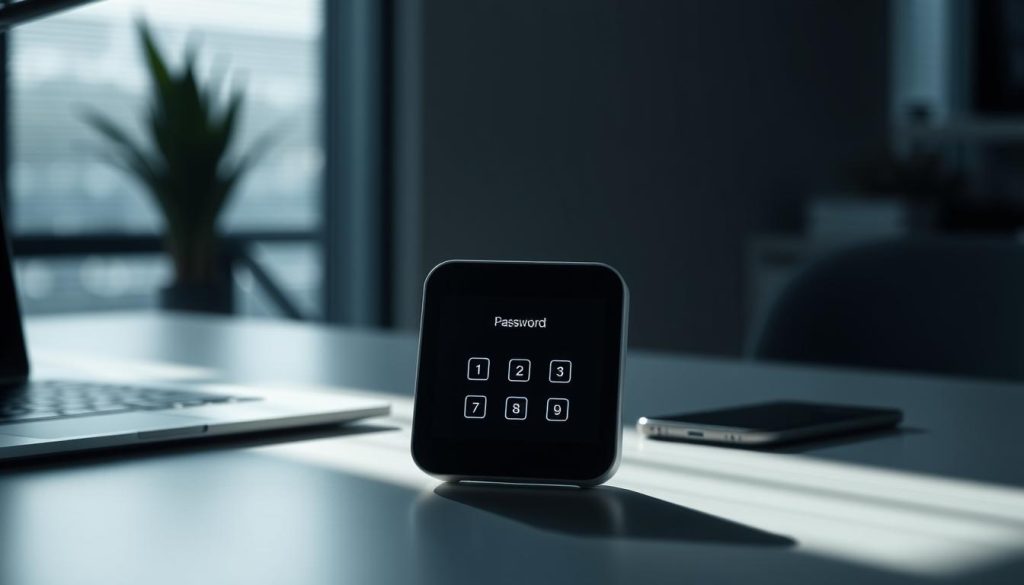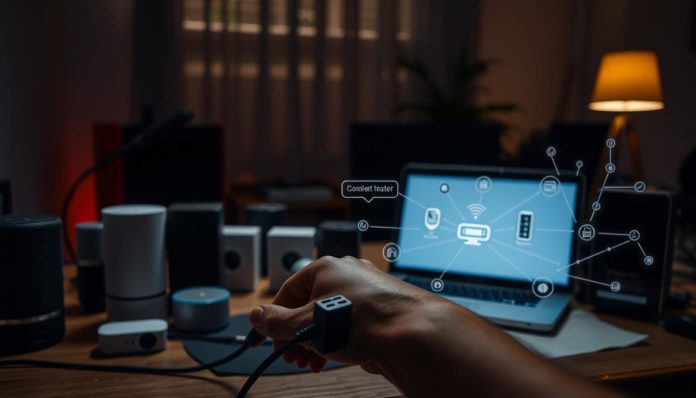The number of IoT devices in homes and offices is growing fast. This has raised big privacy concerns. Many devices have remote access features that can be a risk if not secured well. Turning off these features is key to keeping your personal data safe and improving IoT security.
IoT security is a big worry now. Users need to act fast to protect their devices. One good way to do this is by limiting remote control or access. This simple step can greatly lower the chance of someone getting into your devices and data without permission.
Key Takeaways
- Disabling remote access on IoT devices enhances privacy and security.
- IoT security is a growing concern that requires proactive measures.
- Limiting remote access can significantly reduce the risk of data breaches.
- Users should regularly review and update their IoT device settings.
- Staying informed about IoT security best practices is crucial.
Understanding IoT Devices and Their Risks
IoT devices are now a big part of our lives, but they also raise privacy and security concerns. As you add more devices to your home and daily life, knowing the risks is key.
What Are IoT Devices?
IoT devices are objects that connect to the internet. They can collect, send, and sometimes act on data. Examples include smart home gadgets, security cameras, and wearable tech. They make our lives easier by connecting and sharing data.
Common Security Vulnerabilities
IoT devices come with risks. Some common issues are:
- Weak passwords that hackers can easily guess
- Outdated firmware that leaves devices open to attacks
- Data breaches that put personal info at risk
- Device spoofing, where fake devices trick systems
These problems show why we need strong IoT security tips to keep our devices and data safe.
Why Privacy Matters in IoT
Privacy is a big deal in IoT because these devices collect personal data. Keeping this data safe is vital to stop unauthorized access and misuse. Adjusting IoT device privacy settings helps protect your privacy. By controlling how your data is used, you boost your security and privacy.
To improve your security, it’s important to know the risks and act early. This means checking your devices’ security features and keeping up with the latest IoT security tips.
Reviewing Your IoT Devices and Their Features
To keep your IoT devices safe, start by checking their features. Understand what each device can do and how it’s set up. This helps you spot and fix any security issues.

Identifying Remote Access Capabilities
Many IoT devices let you control them from afar. This is handy but also risky if not managed right. To disable remote control on smart devices, look for the setting in the device’s menu or app.
Smart home gadgets like thermostats and cameras usually have remote access on by default. Make sure to turn it off if you don’t need it. This stops others from getting into your devices.
Assessing Device Vulnerabilities
Every IoT device has its own security risks. To secure your IoT devices, you must find and fix these issues. Common problems include old firmware, weak passwords, and open ports.
- Ensure your device’s firmware is current, as updates often fix security holes.
- Use strong, unique passwords for each device to block unauthorized access.
- Turn off any services or ports you don’t use to reduce risk.
Understanding Default Settings
IoT devices often have default settings that aren’t secure. For example, default passwords are easy for hackers to find. To keep your devices safe, change these settings.
Look in the user manual or the manufacturer’s website for how to change settings. This might include setting new passwords, disabling features you don’t need, and adjusting privacy settings.
How to Disable Remote Access Features
To keep your IoT devices safe from hackers, disabling remote access is key. This simple step boosts your device’s security. It makes sure hackers can’t get into your device’s features or data.
Step-by-Step Guide for Popular Brands
Each IoT brand has its own way to turn off remote access. Here’s a basic guide for some top brands:
- Brand X Smart Thermostats: Go to Settings > Remote Access, and turn off the feature.
- Brand Y Security Cameras: Open the app, go to Device Settings, and disable remote viewing.
- Brand Z Smart Speakers: Use a voice command to disable remote access or adjust settings online.

Adjusting Settings via Mobile Apps
Many IoT devices use mobile apps for control. These apps make it easy to turn off remote access. Here’s how:
- Open the app for your IoT device.
- Go to the device settings or configuration.
- Find the remote access or remote control options.
- Turn off these features.
For example, smart home security systems usually have remote access settings in the app’s settings menu.
Configuring Through Web Interfaces
Some IoT devices let you set up settings online. You do this by going to the device’s IP address in a web browser.
- Type the device’s IP address in your browser.
- Log in with your admin details.
- Go to the remote access or remote management section.
- Disable the remote access feature.
By following these steps, you greatly improve your IoT device security. This helps protect your devices from threats.
Importance of Strong Passwords
To keep smart devices safe, use strong and unique passwords for each one. Weak or default passwords are easy for hackers to guess. This can put your device security at risk.
Creating Unique Passwords for Every Device
Using the same password for many devices is risky. If one device is hacked, others with the same password can be too. Create a unique password for each IoT device to boost security.
A good password mixes letters, numbers, and special characters. Don’t use names or birthdays, as they’re easy to guess.

Utilizing Password Managers
Keeping track of many complex passwords is hard. Password managers can create and store strong, unique passwords for each device. This makes keeping your devices secure easier.
These tools can fill in login details for you. This helps avoid using the same password everywhere and lowers the risk of hackers getting in.
Changing Default Credentials
Many IoT devices come with default passwords that hackers can find easily. Changing these default passwords is key to keeping your devices safe.
When you set up a new device, change the password to a strong, unique one right away. This simple step can greatly improve your device’s security and stop hackers from getting in.
Updating Device Firmware Regularly
Updating your IoT devices’ firmware is a simple yet effective way to boost their security. It helps protect your personal data. Regular updates are key to keeping your Internet of Things (IoT) devices secure and intact.
Firmware Updates Are Crucial
Firmware updates often fix known vulnerabilities, which is vital for stopping unauthorized access. Keeping your firmware current ensures your devices are safe from new threats. Outdated firmware can leave your devices exposed to security risks, making regular updates crucial for your IoT privacy.

Checking for Updates
To find firmware updates, you need to access your device’s settings menu. This can be done through a mobile app or a web interface. It’s essential to regularly check for updates and follow the manufacturer’s instructions for updating the firmware. Some devices may also notify you when an update is ready.
- Open the device’s app or web interface.
- Navigate to the settings or device information section.
- Look for the “Check for Updates” or “Firmware Update” option.
- Follow the prompts to download and install the update.
Setting Up Automatic Updates
Many modern IoT devices allow you to set up automatic firmware updates. This feature ensures your devices always have the latest firmware without needing manual updates. Enabling automatic updates gives you peace of mind, knowing your devices are always protected.
To set up automatic updates, look for the option in your device’s settings menu. Look for terms like “Automatic Updates” or “Auto-Update” and enable it. By doing so, you’re following one of the key Internet of Things security best practices to safeguard your devices and personal data.
Utilizing Network Security Measures
Keeping your network safe is key to protecting your IoT devices and keeping your privacy. A strong network security plan helps keep your devices safe from hackers and data breaches.
Enabling Network Firewalls
A network firewall is like a shield for your network. It checks all traffic coming in and out, stopping any bad stuff.
- Turn on your router’s firewall for extra security.
- Set your firewall to block unwanted connections.
- Keep your firewall updated to fight off new threats.
Using VPNs for Enhanced Privacy
A Virtual Private Network (VPN) wraps your internet connection in a secure blanket. This makes it hard for hackers to get your data.
Using a VPN has many benefits:
- It encrypts your internet traffic, keeping your data safe.
- It hides your IP address, keeping you anonymous.
- It makes public Wi-Fi safer to use.
When picking a VPN, look at things like encryption, server locations, and what they log.
Segmenting Your Network
Network segmentation means breaking your network into smaller, safer parts. This helps stop malware and unauthorized access from spreading.
To segment your network well:
- Make separate networks for IoT devices and important data.
- Use VLANs to keep device groups separate.
- Use access controls to limit how different parts of the network talk to each other.
By using these network security steps, you can make your IoT devices much safer and more private.
Exploring Advanced Privacy Settings
Looking into advanced privacy settings is crucial for securing your IoT devices. By exploring these settings, you can greatly improve your devices’ privacy and security.
Disabling Unused Features and Services
One easy way to boost your IoT device’s privacy is to turn off unused features and services. Many devices have features enabled by default that you might not need.
- Check each feature and service on your device to see if you need it.
- Turn off any unused features to lower the risk of vulnerabilities.
- Keep checking and updating your settings as your needs change.
Review of Privacy Options on Devices
Most IoT devices have privacy options you can adjust to fit your needs. It’s important to understand these options to maximize your device’s privacy.
- Go to your device’s settings menu to look at privacy options.
- Change settings related to data collection, sharing, and use.
- Turn on privacy features like data encryption when you can.
Using Third-Party Privacy Tools
Along with your device’s built-in privacy settings, third-party privacy tools can add extra protection. These tools help manage device permissions, track data use, and block unauthorized access.
- Look for reputable third-party privacy tools that work with your IoT devices.
- Install and set up these tools as the manufacturer says.
- Keep these tools updated to get the latest security fixes.
By following these steps, you can greatly improve your IoT devices’ privacy and security. This ensures a safer connected experience for you.
The Role of Trusted Brands in IoT Security
To keep your smart devices safe from hackers, picking a reliable brand is key. Trusted brands focus on security, offering strong protection for your devices.
Brand Reputation Matters
Checking a brand’s reputation is important when picking secure IoT devices. Start by looking into the brand’s history and their security stance. Also, check for any past security issues with their devices.
- Choose brands known for securing their devices well.
- Look for security certifications and industry standards.
- Read what other customers say to understand their experiences.
Choosing Devices with Strong Security Measures
It’s crucial to pick IoT devices with solid security features. Here are some important things to look for:
| Security Feature | Description | Importance |
|---|---|---|
| Regular Firmware Updates | Keeps devices safe from new threats. | High |
| Strong Password Protection | Blocks unauthorized access to your devices. | High |
| Data Encryption | Secures your data from unauthorized access. | High |
Researching Consumer Reviews and Ratings
Consumer feedback is a great way to learn about IoT devices. Look for:
- Comments on the device’s security features.
- Any security issues or concerns mentioned.
- Comparisons with other devices on the market.
By choosing devices from trusted brands, you lower the risk of hacking. Protecting your IoT devices from hackers involves picking the right brand, understanding security features, and staying updated on threats.
Awareness of Legal and Compliance Issues
Exploring the world of IoT devices means knowing the legal rules. It’s not just about keeping your devices safe. It’s also about following laws and regulations about data privacy and security.
Following the best practices for IoT security is key. It helps you meet legal standards. Knowing these rules is vital for protecting your devices and the data they store.
Understanding Privacy Regulations
Privacy laws, like GDPR in Europe and CCPA in California, have strict rules. They dictate how personal data is handled. As an IoT user, you must know these rules and follow them.
If your IoT devices collect personal data, you must understand its use. Make sure it’s handled legally.
Ensuring Compliance with Local Laws
Following local laws is important. It’s not just to avoid trouble. It’s also about respecting others’ privacy and security. You need to know the laws in your area and follow them.
For example, some places have rules about smart cameras. Following these laws is crucial to avoid legal problems.
The Impact of Data Breaches
Data breaches can lead to big legal and financial troubles. If your IoT devices are hacked, you could face legal action. This is especially true if you didn’t protect them well.
It’s vital to understand the risks of data breaches. To avoid them, use strong security measures. This includes keeping your devices updated and using secure passwords.
Educating Household Members
To keep your IoT devices safe, it’s key to teach everyone in your home about IoT security. Knowing how to protect your digital world makes it safer for everyone.
Discussing Privacy Best Practices
Begin by talking about privacy with your family. Teach them about strong passwords, spotting phishing scams, and being careful online. Regular family talks about these topics boost your home’s security.
Also, explain how to spot and report strange IoT device activities. This helps catch and fix security issues early.
Creating Family Guidelines for IoT Use
Make rules for using IoT devices to keep everyone in sync on security. These rules should cover:
- Safe ways to use IoT devices
- Keeping device software up-to-date
- Not using default passwords
- Being careful with what data you share
Having these rules helps create a secure home environment.
Encouraging Responsible Technology Use
It’s important to teach your family to use technology wisely. Encourage them to:
- Use devices for their right purpose
- Not install apps or firmware without checking
- Check device settings and permissions often
Teaching responsible tech use reduces security risks and makes your home’s digital space safer.
Here’s a simple table to help you track your household’s IoT security practices:
| Household Member | IoT Devices Used | Password Management | Firmware Update Status |
|---|---|---|---|
| John | Smartphone, Smart TV | Using Password Manager | Up-to-date |
| Jane | Laptop, Smart Speaker | Unique Passwords | Needs Update |
| Kids | Tablets, Gaming Consoles | Shared Account | Up-to-date |
The Future of IoT Privacy
As you keep your IoT devices safe, it’s key to think about the future of IoT privacy. New security trends will shape the IoT world.
Advancements in Security Measures
New tech is coming to boost IoT privacy settings. This makes it simpler to keep your devices safe. New security features will offer stronger protection against threats.
Innovative Device Security
Big names like Samsung and Google are pushing for more secure devices. They’re adding advanced security to protect your data better.
Building Trust in IoT
Keeping IoT devices safe is vital for trust in IoT tech. As it grows, makers must focus on security and openness. This will make the IoT safer for everyone.
By keeping up with IoT security news and securing your devices, you can enjoy IoT benefits while keeping your privacy.

